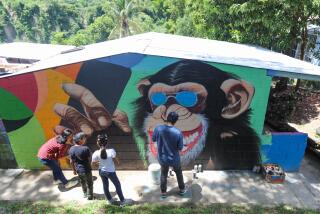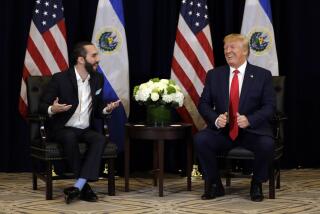Ex-Rebels Woo Salvadoran Voters With Softer Image : Central America: Former leftist guerrillas lead rallies and appear in TV ads. Most have renounced Marxism.
- Share via
SONSONATE, El Salvador — Leftist presidential candidate Ruben Zamora, flanked by former guerrillas who until recently were waging civil war, gazed out Sunday over the smattering of red flags waving in this town’s central plaza.
“(My opponents) want to look at a past of suffering and explosion . . . a past that must be left behind,” he told the small crowd. “(We) want to walk to the future . . . a future that we dreamed of, fought for, year after year.”
In their first foray into civilian politics, El Salvador’s former guerrillas have positioned themselves as the country’s second major political force going into elections next Sunday, polls show. Despite internal divisions and serious organizational problems, the guerrillas, in coalition with four leftist parties, are expected to capture a number of congressional and mayoral seats in El Salvador’s first post-civil war election.
At least 2 million Salvadorans, emerging from more than a decade of fratricidal war that claimed about 75,000 lives, will choose a new president, an 84-member legislature and 262 municipal governments. Rallies this weekend in cities across the country were capping an often violent campaign.
U.N.-brokered peace accords in 1992 ended the war between Marxist rebels of the Farabundo Marti National Liberation Front, or FMLN, and a series of U.S.-backed governments.
The two sides had fought to an impasse, and with the Cold War winding down, both sides were losing their traditional sponsors.
Under the accords, the FMLN disarmed and became a political party in exchange for sweeping military and judicial reforms.
Next Sunday’s elections are seen as an important test of El Salvador’s efforts to heal its wounds and build peace and democracy.
Zamora’s underdog candidacy still lags far behind the ruling party’s Armando Calderon Sol.
But the Zamora coalition has displaced the centrist Christian Democratic Party, which governed from 1984 to 1989 but is saddled with infighting and an uncharismatic candidate.
In a remarkable sign of how things have changed in postwar El Salvador, the men and women who for more than a decade fought to overthrow the government, boycotted elections and burned ballot boxes are now seeking to join the government through elections. With money from Los Angeles and supporters as far-flung as actor Ed Asner, the people who for years worked clandestinely and were branded as terrorists are today campaigning openly.
Hoping to soften their image as warriors, they lead public rallies, appear in television ads, and most have renounced Marxism. Posters with their pictures--images of older, graying former rebels in suits, ties and tasteful jewelry--are plastered all over Salvadoran cities.
Government officials and the right maintain that the FMLN’s changes are superficial and that its talk of democracy and free-market economics is a charade.
Moreover, many Salvadorans are not convinced that the left is capable of governing. Zamora’s party, for example, missed a filing deadline and will lose several seats in the legislature.
“I think Dr. Zamora is a responsible person, but the political forces that accompany him have not completed the transformation process of (becoming) forces that can compete in a democratic election,” said Hector Dada, a political analyst who heads a liberal think tank in San Salvador.
The left is not expected to win the presidential election but is hoping to force a runoff, which is required when no single candidate receives more than 50% of the vote.
Zamora, 51, trails Calderon Sol, of the government’s right-wing Nationalist Republican Alliance, or Arena, by a 2-1 margin.
About a third of the voters, however, either haven’t decided or refuse to reveal their preferences.
Zamora and the FMLN are also hoping to make inroads in local governments.
“Each day we get by with the scene remaining (relatively peaceful), we’ve gained a lot,” Joaquin Villalobos, the most successful of the FMLN’s military strategists, said in an interview. “Really, this is historically the most important campaign ever in this country, despite the problems.”
Zamora, whose brother, an attorney general, was killed by a right-wing death squad in 1980, headed the political arm of the guerrillas throughout the early 1980s. He returned to El Salvador from exile in 1987, ran for office and has served as a legislator for the last three years.
For this election--and only after bitter debate--four leftist parties that are grouped around Zamora forged an alliance with the FMLN, itself an umbrella organization of five parties.
The union has not been a smooth one.
FMLN and Zamora’s faction could not agree on a candidate for the critical post of mayor of San Salvador--so each group is backing its own candidate.
The left’s strategy has been to project a moderate face, attempt to overcome the fear that many Salvadorans have of the FMLN and reach out to El Salvador’s vast, apolitical center.
Zamora shaved his beard and looks more like a university professor than an erstwhile radical. In his television and radio ads, Zamora is careful not to relive the war years. Instead, he focuses on bread-and-butter issues of unemployment and medical care.
This has allowed Calderon Sol and Arena, some of whose leaders in the past have been linked to death squads, to exploit the war to their own end, blaming all the destruction on the guerrillas.
But Zamora and his campaign organizers say they are sure that voters in the center do not want to hear about the war.
Responding to Arena “would put us into an argument about the past, and that’s not where we want to be,” said Bill Zimmerman, a Santa Monica consultant who manages Zamora’s campaign. “If we get into an argument with Arena over anything, we invoke a left-right split that works against us in convincing the middle to come over to us.”
The strategy can be seen, with questionable success, at appearances such as Sunday’s rally in Sonsonate, a town 40 miles west of San Salvador that escaped most of the fighting during the war and never lent much support to the guerrillas. Venturing into regions like this is an attempt to reach the uncommitted, but the crowd at the Sonsonate rally was small and subdued.
The strategy was also evident at the left’s largest rally, held Friday night in the downtown Civic Plaza to wrap up the campaign in the capital. To focus television images of the event on Zamora, senior comandantes of the FMLN were kept off the bandstand.
Villalobos and other top FMLN leaders, wearing red T-shirts and campaign baseball caps, milled about under the stage while Zamora spoke to about 10,000 people who had packed into the plaza and climbed the two soaring bell towers of the Metropolitan Cathedral.
Most of the crowd waved red FMLN flags, however, showing that it is still the former rebels who have the drawing power.
Zamora said he will spend about $800,000 on campaign publicity, believed to be a small fraction of what Arena is spending.
Sources in the campaign estimate that up to one-third of the money is coming from exiles and others living in the United States, where Zamora made several fund-raising trips to Los Angeles, San Francisco, New York and Washington.
Asner, the actor known for his liberal politics, helped with fund-raising letters.
The campaign has been marred by violence, underscoring the tensions that remain after the war.
Several militants from the left and right have been murdered in recent months.
Arena’s closing rally Saturday afternoon erupted in a furious melee as sympathizers of both Arena and the FMLN--egged on by street riffraff--fought with rocks, knives and guns. More than 40 people were injured and at least one was killed.
More to Read
Sign up for Essential California
The most important California stories and recommendations in your inbox every morning.
You may occasionally receive promotional content from the Los Angeles Times.














